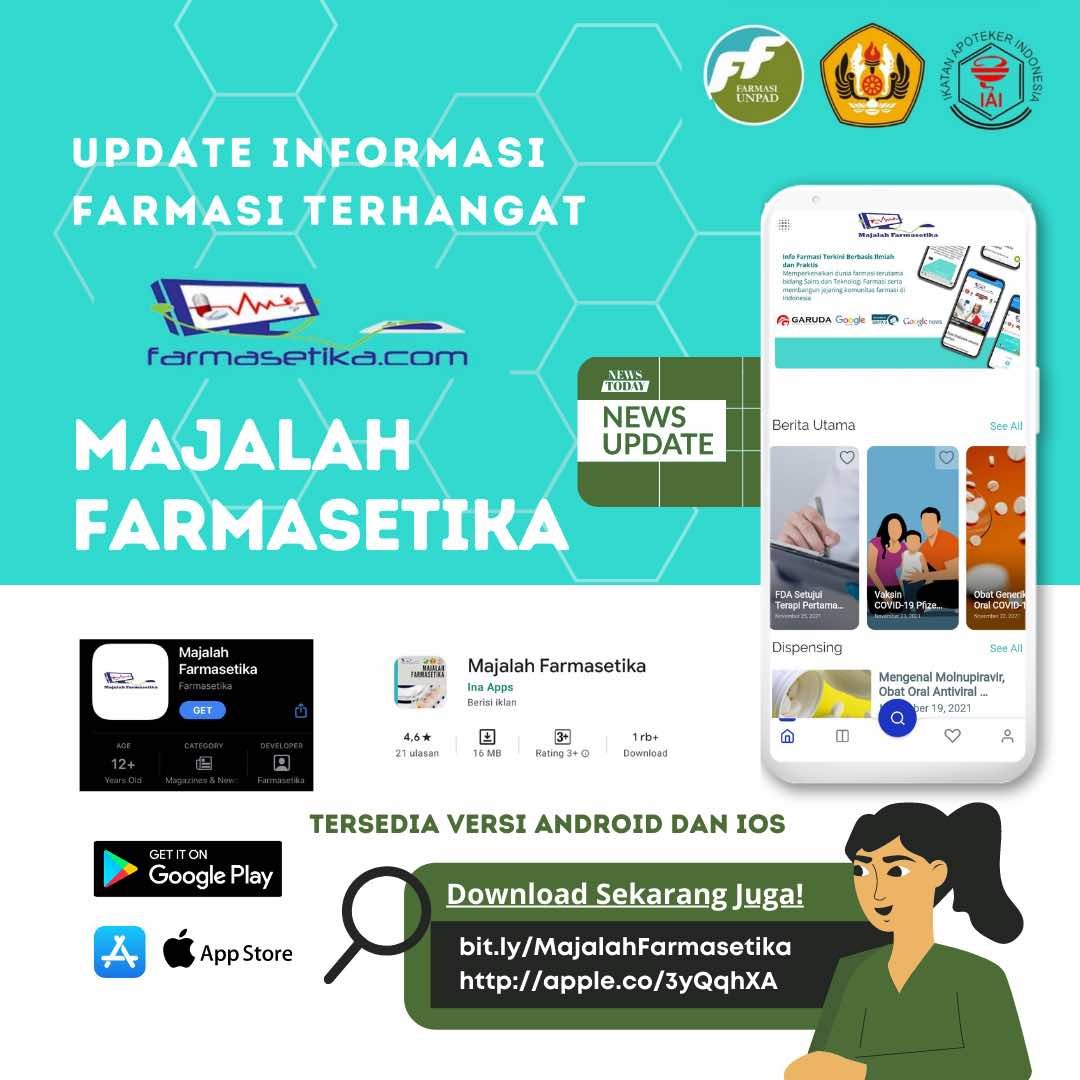Tinjauan Bentuk Sediaan Farmasi Mengandung Peptida
Abstrak
Peptida dan protein merupakan molekul yang memiliki fungsi vital dalam proses biokimia yang terjadi dalam tubuh. Peptida dan protein yang tidak adekuat dapat berpengaruh pada proses metabolisme dan berkaitan dengan kondisi patologis. Kemajuan ilmu pengetahuan dan teknologi membawa penemuan revolusioner dalam dunia medis yaitu menjadikan peptide dan protein sebagai terapi yang menjanjikan untuk pengobatan suatu penyakit. Penelitian di bidang farmasi terus berkembang untuk menemukan dan memproduksi berbagai sediaan farmasi dengan bahan aktif peptide dan protein. Masing-masing bentuk sediaan memiliki kelebihan dan kekurangan serta hambatan tersendiri pada rute administrasinya. Hal tersebut lebih lanjut dibahas pada review ini.
Kata Kunci
Teks Lengkap:
PDFReferensi
Deb, Pran Kishore, et al. Protein/Peptide Drug Delivery Systems: Practical Consideration in Pharmaceutical Product Development. Basic Fundamental of Drug Delivery. s.l. : Elsevier, 2019, pp. 651-684.
Klasifikasi Fungsi Family Protein Transport Menggunakan Radial Basis Neural Network. Sandag, Green Arther and Kaunang, Fergie. 2, 2019, Cogito Smart Journal, Vol. 5, pp. 203-214.
Winarno, F. G. Kimia Pangan dan Gizi. Jakarta : Gramedia Pustaka Utama, 2004.
Voet, D and Voet, J. G. Amino Acid, Biochemistry. 4th. USA : Wiley, 2011.
A Review On The Strategies For Oral Delivery Of Proteins And Peptides And Their Clinical Prospectives. Muheem, Abdul, et al. 4, 2016, Saudi Pharmaceutical Journal, Vol. 24, pp. 413-428.
Dimitrov, Dimiter S. Therapeutic Protein. [ed.] Vladimir Voynov and Justin A. Caravella. Therapeutic Proteins: Methods and Protocols. New Jersey : Humana Press, 2012, pp. 1-26.
Barasi, Mary E. At a Glance Ilmu Gizi. Jakarta : Erlangga, 2009.
Almatsier, Sunita. Prinsip Dasar Ilmu Gizi. Jakarta : Gramedia Pustaka Utama, 2001.
Vyas, S. P and Khar, K. R. Targeted and Controlled Drug Delivery: Novel Carrier System. New Delhi : CBS Publisher, 2002.
Pengaruh Protein Diet terhadap Indeks Glikemik. Probosari, Enny. 1, 2019, Journal Nutrition and Health, Vol. 7, pp. 33-39.
Protein Translocation Across the EUkaryotic Endoplasmic Reticulum and Bacterial Plasma Membranes. Rapoport, Tom A. 7170, 2007, Nature, Vol. 450, pp. 663-669.
Miller, Andrew and Tanner, Julian. Essentials of Chemical Biology. Chichester : John Wiley & Sons, 2008.
Yazid, Estien and Nursanti, Lisda. Penuntun Praktikum Biokimia Untuk Mahasiswa Analis. Yogyakarta : C.V Andi Offset, 2006.
Wolf, Max and Ransberger, Karl. Enzyme-Therapy. New York : Vantage Press, 1972.
Holcenberg, J. S and Roberts, J. Enzymes as Drugs. New York : John Wiley & Sons, 1981.
Joseph, Mary, Trinh, Hoang M. and Mitra, Ashim K. Peptide and Protein-Based Therapeutic Agents. Emerging Nanotechnologies for Diagnostics, Drug Delivery, and Medical Disease. s.l. : Elsevier, 2017, pp. 145-167.
Murtini, Gloria and Elisa, Yetri. Teknologi Sediaan Solid. Jakarta : Kementerian Kesehatan RI, 2018.
Sistem Penghantaran Obat Baru Peroral dengan Pelepasan Terkontrol. Indrawati, Teti. 1, 2011, Sainstech Farmas, Vol. 2, pp. 27-31.
Peptide Therapeutics: Current Status and Future Directions. Fosgerau, Keld and Hoffmann, Torsten. 2015, Drug Discovery Today, pp. 1-10.
Recent Developments in Protein and Peptide Parenteral Delivery Approaches. Patel, Ashaben, Cholkar, Kishore and Mitra, Ashim K. 3, 2014, Therapeutic Delivery, Vol. 5, pp. 337-365.
Basics and Recent Advances in Peptide and Protein Drug Delivery. Bruno, Benjamin J., Miller, Geoffrey D. and Lim, Carol S. 11, 2013, Therapeutic Delivery, Vol. 4, pp. 1443-1467.
Enhancement of the Oral Absorption of Cyclosporin in Man. Drewe, J, et al. 1, 1992, British Journal of Clinical Pharmacology, Vol. 34, pp. 60-64.
Exubera (Inhaled Insulin): an Evidence-Based Review of Its Effectiveness in the Management of Diabetes. Profit, Louise. 2, 2005, Core Evidence, Vol. 1, pp. 89-101.
Inhaled Insulin Using the AERx Insulin Diabetes Management System in Healthy and ASthmatic Subjects. Henry, Robert R, et al. 3, 2003, Diabetes Care, Vol. 26, pp. 746-749.
The Effect of Smoking Cessation and Subsequent Resumption on Absorption of Inhaled Insulin. Becker, Reinhard H. A, et al. 2, 2006, Emerging Treatments and Technologies, Vol. 29, pp. 277-282.
A Review on Penentration Enhancer for Semisolids. Sonje, Abhijit, et al. 5, 2013, Asian Journal of Pharmaceutical Research and Development, Vol. 1, pp. 94-107.
Transdermal Delivery of Peptide and Protein Drugs: an Overview. Amsden, B. G and Goosen, M. F. A. 8, 1995, Bioengineering, Food and Natural Products, Vol. 41, pp. 1972-1997.
Intranasal Bioavailability of Insuline from Carbopol-Based Gel Spray in Rabbits. Najafabadi, Abdolhossein Rouholamini, Moslemi, Payam and Tajerzadeh, Hosnieh. 5, 2004, Drug Delivery, Vol. 11, pp. 295-300.
Shire, Steven J. Formulation of Protein and Monoclonal Antibodies (mAbs). Monoclonal Antibodies. Cambridge : Woodhead Publishing, 2015, pp. 93-120.
Novel Delivery Technologies for Protein and Peptide Therapeutics. Kumar, T. R. S, Soppimath, K. and Nachaegari, S. K. 4, 2006, Current Pharmaceutical Biotechnology, Vol. 7, pp. 261-276.
Long-Term Delivery of Protein Therapeutics. Vaishya, Ravi, et al. 3, 2015, Expert Opinion on Drug Delivery, Vol. 12, pp. 415-440.
Trissel, L. A. Handbook on Injectable Drugs 17th Ed. Bethesda : ASHP, 2013.
Poliovirus, Pathogenesis of Poliomyelitis, and Apoptosis. Blondel, B., et al. 2005, Current Topics in Microbiology and Immunology, Vol. 289, pp. 25-56.
Refbacks
- Saat ini tidak ada refbacks.











